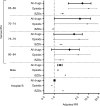Older adults and high-risk medication administration in the emergency department
- PMID: 29184448
- PMCID: PMC5685141
- DOI: 10.2147/DHPS.S143341
Older adults and high-risk medication administration in the emergency department
Abstract
Background: Older adults are susceptible to adverse effects from opioids, nonsteroidal anti-inflammatory drugs (NSAIDs), and benzodiazepines (BZDs). We investigated factors associated with the administration of elevated doses of these medications of interest to older adults (≥65 years old) in the emergency department (ED).
Patients and methods: ED records were queried for the administration of medications of interest to older adults at two academic medical center EDs over a 6-month period. Frequency of recommended versus elevated ("High doses" were defined as doses that ranged between 1.5 and 3 times higher than the recommended starting doses; "very high doses" were defined as higher than high doses) starting doses of medications, as determined by geriatric pharmacy/medicine guidelines and expert consensus, was compared by age groups (65-69, 70-74, 75-79, 80-84, and ≥85 years), gender, and hospital.
Results: There were 17896 visits representing 11374 unique patients >65 years of age (55.3% men, 44.7% women). A total of 3394 doses of medications of interest including 1678 high doses and 684 very high doses were administered to 1364 different patients. Administration of elevated doses of medications was more common than that of recommended doses. Focusing on opioids and BZDs, the 65-69-year age group was much more likely to receive very high doses (1481 and 412 doses, respectively) than the ≥85-year age groups (relative risk [RR] 5.52, 95% CI 2.56-11.90), mainly reflecting elevated opioid dosing (RR 8.28, 95% CI 3.69-18.57). Men were more likely than women to receive very high doses (RR 1.47, 95% CI 1.26-1.72), primarily due to BZDs (RR 2.12, 95% CI 2.07-2.16).
Conclusion: Administration of elevated doses of opioids and BZDs in the older population occurs frequently in the ED, especially to the 65-69-year age group and men. Further attention to potentially unsafe dosing of high-risk medications to older adults in the ED is warranted.
Keywords: NSAIDs; administration; benzodiazepines; emergency department; older adults; opioids.
Conflict of interest statement
Disclosure The authors report no conflicts of interest in this work.
Figures


Similar articles
-
The Effect of Computerized Physician Order Entry Template Modifications on the Administration of High-Risk Medications in Older Adults in the Emergency Department.Drugs Aging. 2017 Oct;34(10):793-801. doi: 10.1007/s40266-017-0489-z. Drugs Aging. 2017. PMID: 28956283
-
Patterns of benzodiazepine administration and prescribing to older adults in U.S. emergency departments.Aging Clin Exp Res. 2020 Dec;32(12):2621-2628. doi: 10.1007/s40520-020-01496-1. Epub 2020 Feb 13. Aging Clin Exp Res. 2020. PMID: 32056152
-
Potentially Inappropriate Medication Prescriptions for Older Adults with Painful Conditions and Association with Return Emergency Department Visits.J Am Geriatr Soc. 2019 Apr;67(4):719-725. doi: 10.1111/jgs.15722. Epub 2019 Jan 27. J Am Geriatr Soc. 2019. PMID: 30687938
-
Pharmacotherapy for Spine-Related Pain in Older Adults.Drugs Aging. 2022 Jul;39(7):523-550. doi: 10.1007/s40266-022-00946-x. Epub 2022 Jun 27. Drugs Aging. 2022. PMID: 35754070 Review.
-
Pharmacological treatments for low back pain in adults: an overview of Cochrane Reviews.Cochrane Database Syst Rev. 2023 Apr 4;4(4):CD013815. doi: 10.1002/14651858.CD013815.pub2. Cochrane Database Syst Rev. 2023. PMID: 37014979 Free PMC article. Review.
Cited by
-
Emergency Department Programs to Support Medication Safety in Older Adults: A Systematic Review and Meta-Analysis.JAMA Netw Open. 2025 Mar 3;8(3):e250814. doi: 10.1001/jamanetworkopen.2025.0814. JAMA Netw Open. 2025. PMID: 40067297 Free PMC article.
-
Emergency Department Utilization Among People Living With HIV on Chronic Opioid Therapy.J Int Assoc Provid AIDS Care. 2021 Jan-Dec;20:23259582211010952. doi: 10.1177/23259582211010952. J Int Assoc Provid AIDS Care. 2021. PMID: 33888001 Free PMC article.
-
Safety and Efficacy of Low-Dose Versus High-Dose Parenteral Ketorolac for Acute Pain Relief in Patients 65 Years and Older in the Emergency Department.Cureus. 2023 Jun 12;15(6):e40333. doi: 10.7759/cureus.40333. eCollection 2023 Jun. Cureus. 2023. PMID: 37456458 Free PMC article.
-
Concurrent Use of Opioids with Other Central Nervous System-Active Medications Among Older Adults.Popul Health Manag. 2020 Aug;23(4):286-296. doi: 10.1089/pop.2019.0128. Epub 2019 Nov 25. Popul Health Manag. 2020. PMID: 31765280 Free PMC article.
-
Low Back Pain Presentation and Management at the Emergency Department: Differences Between Older Adults Residing in the Community and Aged Care Homes.J Eval Clin Pract. 2025 Apr;31(3):e70088. doi: 10.1111/jep.70088. J Eval Clin Pract. 2025. PMID: 40214149 Free PMC article.
References
-
- Federal Interagency Forum on Aging-Related Statistics . Older Americans 2016, Key indicators of well-being. Washington, DC: Federal Interagency Forum on Aging-Related Statistics; 2016. [Accessed August 12, 2017]. Available from: https://agingstats.gov/docs/LatestReport/Older-Americans-2016-Key-Indica....
-
- Samaras N, Chevalley T, Samaras D, Gold G. Older patients in the emergency department: a review. Ann Emerg Med. 2010;56(3):261–269. - PubMed
-
- Weiss AJ, Wier LM, Stocks C, Blanchard J. Overview of Emergency Department Visits in the United States, 2011: Statistical Brief #174. Rockville, MD: Healthcare Cost and Utilization Project (HCUP) Statistical Briefs; 2006. - PubMed
Grants and funding
LinkOut - more resources
Full Text Sources
Other Literature Sources

